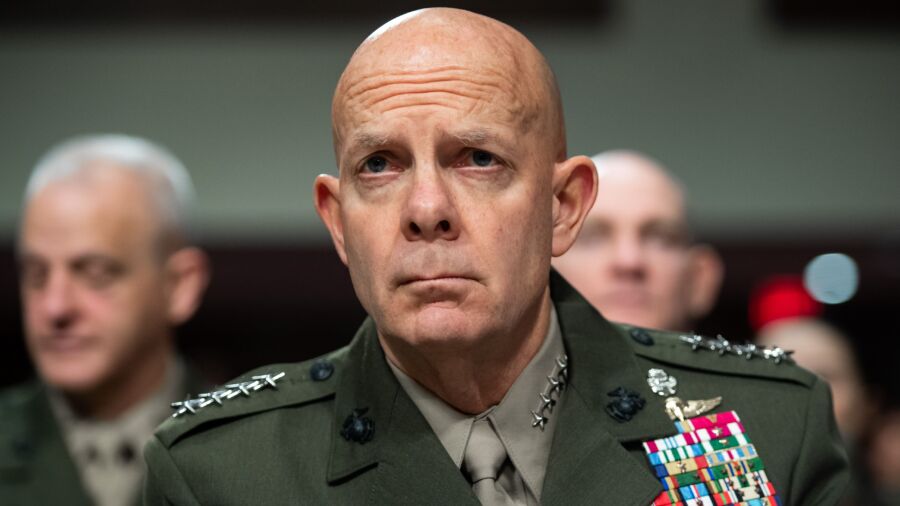The U.S. Marine Corps’s top officer has expressed regret that the service wasn’t better prepared to help evacuate Americans from Sudan. He warned that cutting amphibious ships from the U.S. fleet would leave gaps whereby ground commanders couldn’t rely on the Marines to provide a seaborne emergency response force.
During a House Armed Services Committee hearing on Friday, the Commandant of the Marine Corps, Gen. David H. Berger, indicated that Marines haven’t been available to evacuate Americans amid a burgeoning civil war in Sudan.
“The last couple weeks in Sudan, I feel like I let down the combatant commander because General Langley needs options; he didn’t have a sea-based option,” Berger said, referring to U.S. Africa Command (AFRICOM) commanding Gen. Michael Langley.
U.S. special operations troops evacuated the U.S. Embassy in Khartoum by helicopter last weekend as fighting between warring Sudanese factions spread to the country’s capital city. While around 100 U.S. embassy personnel were evacuated, the United States has offered less help evacuating citizens in the country during this growing crisis.
At least two U.S. citizens in Sudan have been killed since the fighting erupted on April 15. One was a civilian whom officials said was caught in the crossfire, and the other was a doctor from Iowa City, Iowa, who was stabbed to death in front of his house and family in Khartoum amid the lawless violence that accompanied the fighting.
U.S. forces assisted in the first evacuation of non-embassy civilians on Sunday. U.S. unmanned aircraft provided armed oversight for buses with 200 to 300 Americans driving 500 miles to a relatively safe evacuation point at Port Sudan.
Berger said a sea-based force like a Marine Expeditionary Unit (MEU) offers “the best chance you have of responding” specifically to an embassy evacuation mission like the one in Sudan, “because [an embassy is] sovereign territory and you can solve a lot of problems coming for your own sovereign territory from the sea.” He said the Marines should have at least one amphibious unit available in the Pacific, Mediterranean, and Africa year-round for that reason.
Navy Force Debate
Berger cited the unavailability of Marines to respond rapidly to the Sudan crisis or the earthquake in Turkey in February as reasons why Congress should not allow the U.S. Navy to operate fewer than 31 amphibious ships for the Marine Corps.
The Navy and the Marine Corps (both organized under the Department of the Navy) are in an internal budget standoff over the structure of the Navy fleet. While Berger wants more ships that can serve to transport and deploy his force, the Navy wants to pause the expansion of its amphibious fleet while building additional submarines and guided-missile destroyers and frigates.
This year, the Navy submitted the fiscal year 2024 budget proposal that would see the service cut three of its older dock landing ships (LSDs) while pausing deliveries of replacement San Antonio-class amphibious transport dock ships (LPDs).
Berger said if the Navy dropped below the 31 amphibious ship threshold, “We would have gaps during the year when we would not have an at-sea capability for the combatant commander when something happened. We would not be deterred. We would not be in a position to respond.”
Berger said the Navy’s amphibious ships are crucial for the Marine Corps mission.
“That’s how we reinforce embassies, that’s how we evacuate them, that’s how we deter; so one, the crisis part; two, the deterrence part,” Berger said. “[Having fewer amphibious ships] opens up risks for the combatant commander. We have to have 31 at a minimum. Nothing less.”
Berger has also emphasized expanding the Marine Corps’ amphibious capabilities as part of his concept for the future design of the force, known as Force Design 2030. His force design idea calls for enabling the Marine Corps to rapidly deploy from island to island in the Indo-Pacific region to counter the People’s Republic of China (PRC).
In a prepared statement before the hearing, Berger said, “In my opinion, there is also a soft power component to our amphibious warfare ships that cannot be replaced by other platforms. It is obvious the PRC is learning this lesson and is pursuing their own amphibious warfare ship program as a competitive act.”
Navy Secretary Carlo Del Toro defended the Navy’s plan to momentarily pause construction on new amphibious ships, saying he hopes the keep the pause “as short as it can possibly be.”
“There is unquestionably a need for a heavy lift when it comes to fulfilling the Marine Corps’ responsibilities in [the U.S. Indo-Pacific Command] and crisis situations around the world,” Del Toro said.
Del Toro said he supports a requirement of 31 amphibious warships. Still, he said some of the existing LSDs cannot fulfill the needs of the Marine Corps in its model of a sea-based crisis response force, known as an Amphibious Ready Group/Marine Expeditionary Unit (ARG/MEU).
“We need to retire some of those LSDs, so we can use those monies more wisely in the investments of future LPDs,” Del Toro said.
The Navy’s decision to pause building new amphibious ships came at the direction of the Office of the Secretary of Defense (OSD). When asked who directed the pause on amphibious ships, Navy Under Secretary Erik Raven told USNI News, “We received direction from OSD.”

